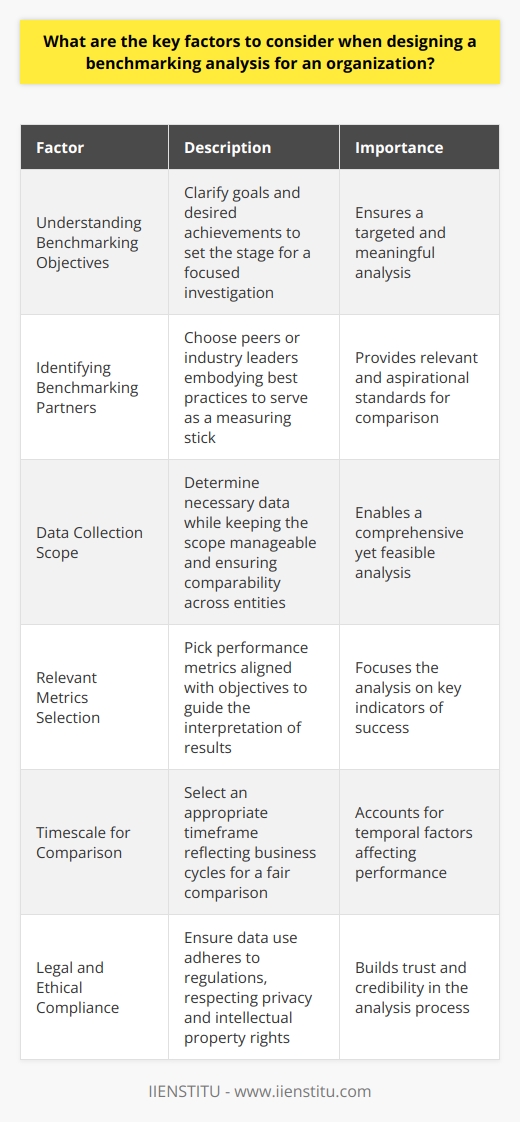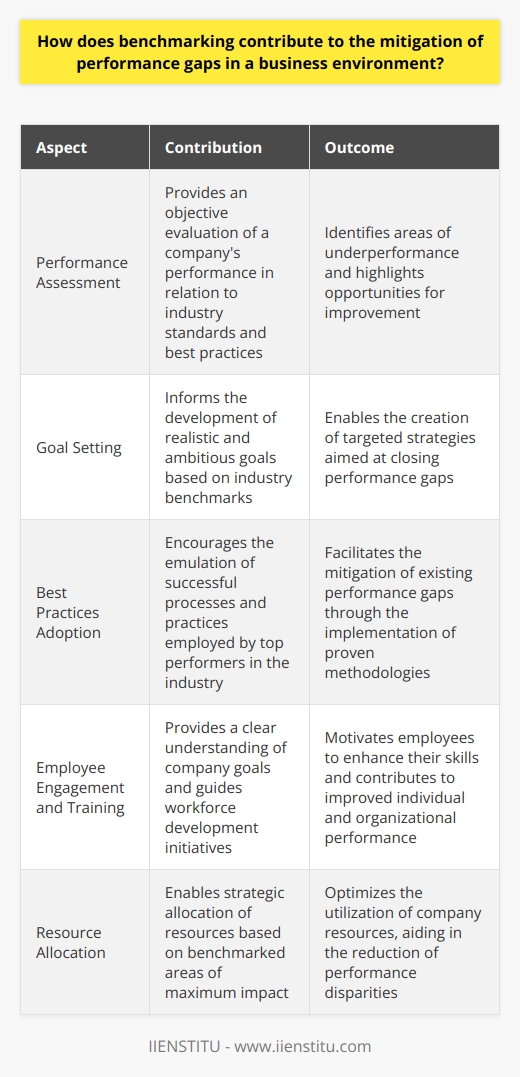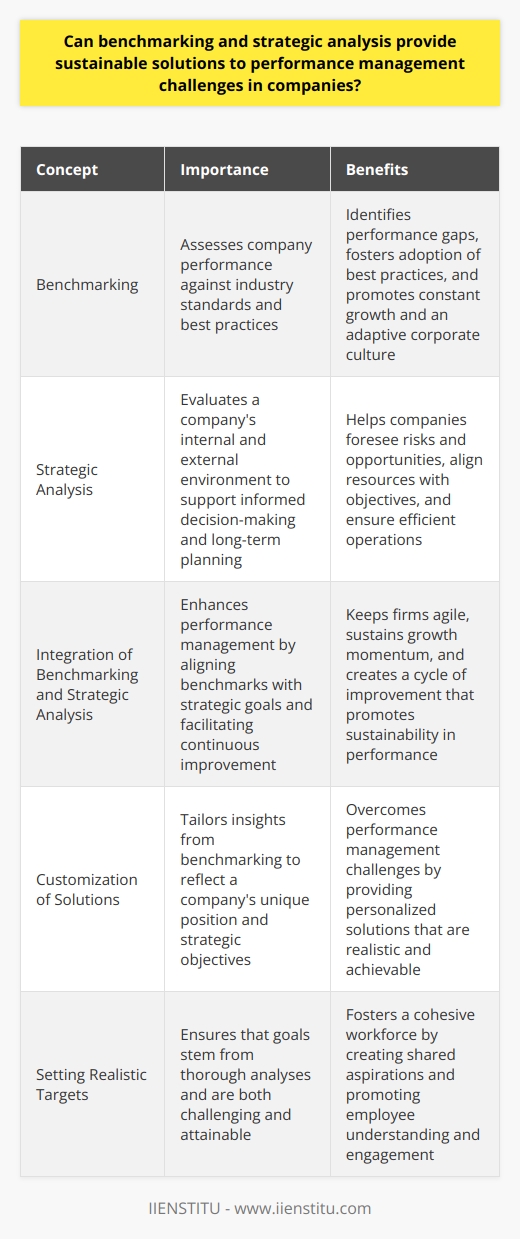
In the competitive arena of business, companies frequently search for methodologies to surpass rivals and enhance performance. Benchmarking is a pivotal instrument in this quest, serving as a compass to navigate the complex seas of strategic planning and operational efficiency. This blog will delve into the essence of benchmarking, elucidating its concept, process, and practical implications. The discourse will unfold the significance of harnessing benchmarking for bridging performance gaps, drawing from empirical insights and scholarly investigations.
Our objective is to furnish business professionals and academics with a comprehensive understanding of benchmarking's role in contemporary commercial practices and to establish a dialogue about its enduring relevance in pursuit of corporate preeminence.
Understanding the Concept of Benchmarking
At its core, benchmarking is a systematic approach to identifying the best practices from industry leaders that can potentially be replicated and adapted within an organization to boost performance. The idea of benchmarking is far from novel; it traces back to ancient times when craftsmen measured their work against standards or "benches". However, it has evolved substantially, allowing businesses to not only measure products but also services and processes against those perceived as best in class.
Detailed explanation of the term
Today, benchmarking is an intricate process which embarks on a variety of forms. These forms range from internal benchmarking, comparing practices within different departments of the same organization, to competitive benchmarking, which meticulously analyzes direct competitor strategies, and functional and generic benchmarking, which transcend industry boundaries in the quest for best practices in particular functions or processes.
Such depth and breadth of categorization render benchmarking a multifaceted tool, ideally suited for addressing a wide array of organizational challenges.
The relevance of benchmarking in modern business scenario
The modern business environment, characterized by rapid technological advancements and dynamic market forces, has made benchmarking more relevant than ever. It is instrumental in identifying performance gaps and injecting a new lease of life into stagnant corporate structures. By rigorously analyzing how peer companies achieve efficiency, customer satisfaction, or innovation, organizations can replicate success while avoiding the pitfalls of trial and error.
The strategic weight of benchmarking in decision-making is increasingly recognized, establishing it as a cornerstone of organizational progress.
The Process of Benchmarking
To embrace benchmarking effectively, one must understand it is a meticulously charted journey, rather than a destination. It commences with the recognition of sectors within an entity ripe for improvement. Leaders must scrutinize their operation panorama, discerning specific aspects where performance lags behind industry exemplars.
Step-by-step guide to benchmarking
Identifying benchmarks commences with a meticulous understanding of a company's current state, setting the foundation for incremental enhancements. This typically involves a thorough examination of problem areas within processes, products, or services. Successive to this analysis, one determines industry vanguards to be benchmarked, collecting pertinent data for proclaimed introspection. Constructive benchmarking entails assiduous observations, scrupulously comparing one's own performance against that gleaned from leaders. Adjustments meant to bridge deficiencies ensue, aiming to escalate the company's performance metrics.
Illustration with real business examples
Real-world applications of benchmarking are extensive across industries. For instance, in the manufacturing sector, companies often turn to benchmarking to streamline their supply chain operations, sometimes by taking inspiration from firms excelling in logistics online course offerings. The service sector equally benefits; hospitality businesses may benchmark customer service protocols against those of luxury hotels famed for their exemplary customer care, leading to enhanced guest satisfaction and loyalty.
Benefits and Limitations of Benchmarking
Benchmarking, when well-implemented, reaps a multitude of benefits for an organization. It is not an exhaustive analysis but a strategic tool to leapfrog competition and achieve remarkable improvements in various facets of operation.
Detailed discussion on advantages of benchmarking
The potency of benchmarking lies in its capacity to elevate a firm's competitiveness by highlighting areas of subpar performance and presenting pathways to excellence. It is a fulcrum for efficiency, often leading to cost reductions and operational enhancements that streamline production or service delivery. Furthermore, engaging in this practice fosters a culture of innovation and incessant learning, keeping businesses agile and responsive to industry transformations.
Outline potential challenges and limitations
Yet, this strategic tool is not without its challenges. Discerning an appropriate benchmark can be arduous when there is a disparity in scale, scope, or industry. Furthermore, a misshapen interpretation of data could culminate in misguided strategies that miscarry to instil the desired improvements. A notable resistance to change within an organization may also stymie efforts to assimilate and apply the insights gained from benchmarking endeavors.
Tips and Best Practices for Successful Benchmarking
To reap the benefits of benchmarking, one must strategically approach its execution with considerable forethought and precision. Numerous methodologies have been outlined, yet several key practices resonate universally.
Strategies for effective benchmarking process
Establishing lucid objectives underpins a fruitful benchmarking procedure, providing direction and purpose to the endeavor. The accuracy of data, collected consistently and rigorously, is the lifeblood of benchmarking. It is essential for the data to be reliable to facilitate genuine comparison and engender valid conclusions.
Continuous evaluation is another integral component, fostering an enduring commitment to improvement and the enhancement of benchmarks over time.
Sharing case studies of successful benchmarking practices
Technology companies, particularly those focused on software development and digital services, often demonstrate cutting-edge benchmarking strategies. They identify metrics such as user engagement, system uptime, and deployment frequency, implementing robust monitoring systems to gauge their effectiveness against other industry giants. In healthcare, organizations benchmark patient care techniques against those of institutions recognized for high-quality care, leading to improved patient outcomes and operational efficiency. These instances display how transformative benchmarking can be across disparate sectors.
As we have explored, benchmarking is not merely a tool for measurement but a strategic analysis that bridges performance gaps. It is a comprehensive approach, facilitating an understanding of industry standards, accentuating advantages, and encapsulating the ingenuity and resilience of businesses aspiring to excel. We invite readers to reflect on the insights offered within this exploration and encourage the sharing of personal experiences or reflections on benchmarking practices.
Frequently Asked Questions
What are the key factors to consider when designing a benchmarking analysis for an organization?
Understanding Benchmarking Objectives
Before diving into the analysis, clarify your goals. Know what you aim to achieve. This sets the stage for a focused investigation.
Identifying Benchmarking Partners
Choose peers or leaders in your industry. Seek those embodying best practices. They serve as a measuring stick for your analysis.
Data Collection Scope
Determine what data you need. Keep the scope manageable but relevant. Ensure data comparability across different entities.
Relevant Metrics Selection
Pick metrics that matter for performance. They should align with your objectives. These guide the interpretation of your analysis results.
Timescale for Comparison
Select an appropriate timeframe. Ensure it reflects business cycles. This ensures a fair comparison.
Considering Industry Variability
Account for sector-specific nuances. These can skew your analysis. Recognize the impact of new trends or seasonal shifts.
Adjusting for Scale
Remember size differences between entities. Adjust metrics to level the playing field. This allows for more meaningful comparisons.
Legal and Ethical Compliance
Ensure data use adheres to regulations. Respect privacy and intellectual property rights. Ethical practices build trust in your analysis.
Protecting Confidentiality
Only use data authorized for benchmarking. Establish non-disclosure agreements if needed. This safeguards sensitive information.
Tool and Methodology Consistency
Employ consistent tools and methods. This ensures repeatability and reliability. Adherence to standard procedures guarantees the validity of your analysis.
Embracing Technology
Leverage cutting-edge software for data analysis. This enhances efficiency and accuracy. Make sure the technology aligns with your data requirements.
Fostering Stakeholder Engagement
Involve those affected by the analysis. Their insights can enrich the process. Their buy-in is crucial for implementing improvements.
Ongoing Review and Adaptation
Aim for continuous improvement. Keep refining your benchmarking approach. Adapt to the evolving business landscape.
Building in Flexibility
Ensure your benchmarking can adapt over time. This allows for refreshed analyses in the future. Adaptability is key in a dynamic environment.
Communicating Results Effectively
Share your findings in a clear manner. Craft reports that stakeholders can understand. Effective communication breeds organizational learning.

How does benchmarking contribute to the mitigation of performance gaps in a business environment?
Benchmarking and Performance Gap Mitigation
Defining Benchmarking
Benchmarking functions as a key business tool. It involves comparing firm-specific processes with those of competitors or industry leaders. Companies use benchmarking to gauge their performance. Objectively, it assesses where they stand in relation to best practices.
Impact on Performance Gaps
Performance gaps appear when companies fall short of industry standards. These deficiencies often manifest in productivity, quality, or efficiency. Benchmarking shines a light on these areas. It offers insights into the performance levels of peers and sector leaders.
Identification of Areas of Improvement
Identifying strengths and weaknesses becomes straightforward through benchmarking. Managers can pinpoint exactly where the company underperforms. They gain a clear framework for improvement. Benchmarking thus sets the stage for targeted, impactful change.
Goal Setting and Strategy Development
Clear goals are crucial for effective performance management. Benchmarking informs realistic and ambitious goal setting. It helps companies understand what is achievable. Firms can then craft strategies that specifically aim to close performance gaps.
Adoption of Best Practices
Benchmarking encourages the adoption of industry best practices. Businesses learn how top performers operate. They can model their processes after these successful practices. This emulation contributes to mitigating existing performance gaps.
Encourages Continuous Improvement
The benchmarking process fosters a culture of continuous improvement. It challenges companies to keep evolving. Businesses remain vigilant about industry changes and innovations. They adapt more swiftly and effectively.
Provides Objective Performance Metrics
*Metrics matter.* Benchmarking provides quantifiable data. Companies now have objective criteria against which to measure performance. Quantifiable improvements can indicate decreasing performance gaps.
Drives Employee Engagement and Training
Employees benefit from a clear understanding of company goals. Benchmarking can motivate and guide workforce training and development. Workers see the value in skill enhancement to meet benchmarked standards. This eventually leads to better individual and company performance.
Enhances Customer Satisfaction
Improved processes often lead to better customer service. Benchmarking helps identify the service levels of top players. Companies understand how to enhance customer interactions. Satisfied customers are a sign of reduced performance gaps.
Facilitates Resource Allocation
Efficient resource allocation becomes easier with benchmarking. Firms understand where to invest for maximum impact. They optimize the use of their resources. This strategic allocation aids in bridging performance disparities.
Allows for Measurable Progress Tracking
Progress tracking is crucial to closing performance gaps. Benchmarking provides a baseline for this tracking. Firms can monitor their advancements over time. They can adjust strategies as necessary to continue improvement.
Conclusion
In conclusion, benchmarking stands as a vital tool for companies seeking to mitigate performance gaps. It provides clear direction and tangible metrics for improvement. Regular benchmarking ensures that businesses stay on top of trends and maintain competitiveness.

Can benchmarking and strategic analysis provide sustainable solutions to performance management challenges in companies?
Understanding Benchmarking and Strategic Analysis
Benchmarking and strategic analysis stand as pivotal tools. They guide decision-making in business. These practices assess company performance against standards. Often, benchmarks derive from industry best practices. They offer insights for performance improvement.
Benchmarking for Comparative Advantage
Identifying Performance Gaps
Companies thrive on competitive advantage. Benchmarking aids in identifying gaps. It allows for performance comparisons. Businesses see where they rank. They understand their market position better.
Fostering Best Practices
Adoption of best practices becomes possible. Businesses learn from leaders. They integrate successful strategies. This adoption promotes constant growth. It advocates for an adaptive corporate culture.
Strategic Analysis for Informed Decisions
Evaluating Business Environment
Strategic analysis evaluates a company's environment. It scrutinizes internal and external factors. This evaluation supports informed decisions. It also shores up long-term planning. Firms foresee risks and opportunities.
Aligning Resources
Companies align resources with objectives. Strategic analysis defines needed changes. It directs resource allocation. This ensures efficient operations. Resources meet the most crucial needs.
Integrating Both for Sustainability
Enhancing Performance Management
Integration promises enhanced performance management. Companies align benchmarks with strategic goals. They track progress with precision. Adjustments happen swiftly. This approach keeps firms agile. It sustains growth momentum.
Creating a Cycle of Improvement
A cycle of improvement emerges. Insights lead to action. Actions bring results. Companies review these results. The cycle repeats. It facilitates continuous enhancement. It promotes sustainability in performance.
Overcoming Performance Management Challenges
Customizing Solutions
One size does not fit all. Customization proves imperative. Solutions from benchmarking are tailored. They reflect a company's unique position. They also consider strategic objectives. This personalized approach overcomes challenges.
Setting Realistic Targets
Targets become realistic. They stem from thorough analyses. These targets challenge yet remain achievable. Employees understand and relate to them. Goals become shared aspirations. This fosters a cohesive workforce.
Conclusion: Benchmarking and Strategic Analysis Synergy
In practice, these tools show synergy. They deliver sustainable solutions to performance management. Companies remain relevant and competitive. They adapt to evolving business landscapes. The results? Enhanced productivity and lasting success.



